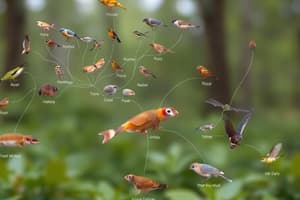Podcast
Questions and Answers
Herbivores eat ______, while carnivores feed on other animals.
Herbivores eat ______, while carnivores feed on other animals.
plants
A food web consists of interconnected food ______ within an ecosystem.
A food web consists of interconnected food ______ within an ecosystem.
chains
Producers are ______ at the base of the trophic levels.
Producers are ______ at the base of the trophic levels.
autotrophs
DNA is a complex molecule that carries ______ information.
DNA is a complex molecule that carries ______ information.
A chromosome is found in the ______ of most living cells.
A chromosome is found in the ______ of most living cells.
A ______ is a specific sequence of nucleotides located on a chromosome.
A ______ is a specific sequence of nucleotides located on a chromosome.
Homozygous individuals inherit the same version of a ______ from both parents.
Homozygous individuals inherit the same version of a ______ from both parents.
Genes can code for proteins or other ______ molecules.
Genes can code for proteins or other ______ molecules.
The equation for photosynthesis is 6CO2 + 6H2O > C6H12O6 + 6______
The equation for photosynthesis is 6CO2 + 6H2O > C6H12O6 + 6______
Photosynthesis occurs in plants, algae, and some ______
Photosynthesis occurs in plants, algae, and some ______
The light-dependent reactions occur in the thylakoid membranes of ______
The light-dependent reactions occur in the thylakoid membranes of ______
Cellular respiration occurs in all living organisms, including plants, animals, and ______
Cellular respiration occurs in all living organisms, including plants, animals, and ______
The Citric Acid Cycle takes place in the ______ matrix
The Citric Acid Cycle takes place in the ______ matrix
Basal Metabolic Rate (BMR) is the minimum calories your body needs at ______
Basal Metabolic Rate (BMR) is the minimum calories your body needs at ______
A catalyst is a substance that speeds up a chemical reaction without undergoing permanent ______ itself
A catalyst is a substance that speeds up a chemical reaction without undergoing permanent ______ itself
Autotrophs synthesize their own food using ______ or chemosynthesis
Autotrophs synthesize their own food using ______ or chemosynthesis
Flashcards are hidden until you start studying
Study Notes
Photosynthesis and Cellular Respiration
- Photosynthesis equation: 6CO2 + 6H2O > C6H12O6 + 6O2
- Occurs in plants, algae, and some bacteria; utilizes chloroplasts.
- Light-dependent reactions take place in thylakoid membranes, while Calvin cycle occurs in chloroplast stroma.
- Cellular respiration equation: C6H12O6 + 6O2 > 6CO2 + 6H2O.
- Cellular respiration happens in all organisms, including plants, animals, and microorganisms.
Cellular Respiration Processes
- Glycolysis: Occurs in cytoplasm and initiates glucose breakdown.
- Citric Acid Cycle (Krebs Cycle): Takes place in mitochondrial matrix, producing energy carriers.
- Electron Transport Chain (ETC): Located in inner mitochondrial membrane, generates ATP via oxidative phosphorylation.
Metabolism
- Metabolism encompasses all chemical processes in living organisms to maintain life.
- Converts nutrients into energy, facilitating breathing, digestion, and hormone regulation.
- Basal Metabolic Rate (BMR) represents the minimum energy needed at rest, accounting for 60%-70% of energy use.
Catalysts
- Catalysts speed up chemical reactions without undergoing permanent change.
- Can be natural (enzymes) or synthetic, optimizing reaction conditions and rates.
Autotrophs and Heterotrophs
- Autotrophs (producers) synthesize their own food via photosynthesis or chemosynthesis.
- Heterotrophs (consumers) rely on other organisms for nutrition, including herbivores (primary consumers) and carnivores (secondary/tertiary consumers).
Food Webs and Trophic Levels
- Food webs are interconnected food chains showcasing the flow of energy and nutrients in ecosystems.
- Trophic levels reflect hierarchical feeding stages: producers, consumers (herbivores and carnivores), and decomposers.
- Trophic pyramids illustrate energy transfer; energy decreases from producers to top carnivores.
Genetic Information and Heredity
- DNA (Deoxyribonucleic Acid) encodes genetic information and is structured as a double helix composed of nucleotides (A, T, C, G).
- Heredity involves the genetic transmission of traits from parents to offspring.
Chromosomes and Genes
- Chromosomes are threadlike structures in the nucleus, carrying genetic information through genes.
- Genes are specific nucleotide sequences on chromosomes that determine characteristics and may code for proteins.
Heterozygous and Homozygous
- Homozygous: Inherits the same gene version from both parents (e.g., two blonde hair alleles).
- Heterozygous: Inherits different gene versions from each parent (e.g., one blonde hair allele and one dark hair allele).
Studying That Suits You
Use AI to generate personalized quizzes and flashcards to suit your learning preferences.




